
|
It approached to Earth down to 0.3 a.u. in mid February, and brightened up to 5.5 mag (Feb. 13, Juan Jose Gonzalez). Now it is fading. But it is still bright as 9.8 mag (Apr. 2, Juan Jose Gonzalez). In the Southern Hemisphere, it is not observable now. In the Northern Hemisphere, it will be getting lower gradually after this.
Date(TT) R.A. (2000) Decl. Delta r Elong. m1 Best Time(A, h)
Apr. 6 4 24.59 33 19.5 1.886 1.548 55 11.2 19:51 (108, 37)
Apr. 13 4 24.14 33 20.8 2.087 1.605 48 11.7 19:58 (112, 30)
|

|
It brightened up to 7.7 mag in June (June 19, Juan Jose Gonzalez). Now it is fading. But it is still bright as 12.8 mag (Apr. 7, Chris Wyatt). In the Southern Hemisphere, it stays observable in good condition for a long time until the comet will fade out. In the Northern Hemisphere, it is not observable for a long time until autumn when the comet fades out down to 16 mag.
Date(TT) R.A. (2000) Decl. Delta r Elong. m1 Best Time(A, h)
Apr. 6 4 36.67 -47 8.4 3.616 3.439 71 12.4 19:51 ( 38, -9)
Apr. 13 4 46.11 -44 43.1 3.702 3.494 70 12.5 19:58 ( 43,-11)
|

|
Now it is not observable. It will appear in the morning sky again at 13-14 mag in August.
Date(TT) R.A. (2000) Decl. Delta r Elong. m1 Best Time(A, h)
Apr. 6 2 12.41 12 13.0 2.930 2.014 19 12.4 19:51 (105, 0)
Apr. 13 2 28.89 13 23.2 2.955 2.016 16 12.4 19:58 (109, -3)
|
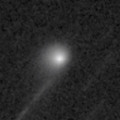
|
Now it is not observable. It will appear in the morning sky in mid May in the Southern Hemisphere, or in late June in the Northern Hemisphere.
Date(TT) R.A. (2000) Decl. Delta r Elong. m1 Best Time(A, h)
Apr. 6 1 37.82 -9 57.9 4.694 3.762 18 13.1 19:51 ( 92,-20)
Apr. 13 1 42.66 -8 23.6 4.668 3.726 17 13.1 19:58 ( 98,-25)
|
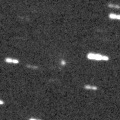
|
Now it is bright as 13.5 mag (Mar. 3, Taras Prystavski). It stays 13 mag for a long time in 2019. In the Southern Hemisphere, it is observable in excellent condition. In the Northern Hemisphere, it is not observasble until summer in 2020.
Date(TT) R.A. (2000) Decl. Delta r Elong. m1 Best Time(A, h)
Apr. 6 7 59.09 -58 25.1 2.759 3.143 103 13.2 19:51 ( 7, -4)
Apr. 13 7 47.18 -57 24.7 2.783 3.126 100 13.1 19:58 ( 13, -5)
|

|
Now it is 13.9 mag (Apr. 6, Martin Masek). It stays 13-14 mag until summer. It is observable in excellent condition in the Southern Hemisphere. In the Northern Hemisphere, it will be getting lower gradually, and it will be unobservable in July.
Date(TT) R.A. (2000) Decl. Delta r Elong. m1 Best Time(A, h)
Apr. 6 17 14.49 -29 45.9 2.781 3.335 115 13.5 4:14 (359, 25)
Apr. 13 17 5.47 -31 46.0 2.688 3.351 123 13.4 3:44 ( 0, 23)
|
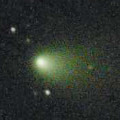
|
Now it is 12.8 mag (Apr. 7, Chris Wyatt). It is observable in excellent condition in the Northern Hemisphere. It locates somewhat low in the Southern Hemisphere.
Date(TT) R.A. (2000) Decl. Delta r Elong. m1 Best Time(A, h)
Apr. 6 11 1.90 28 22.6 1.348 2.178 135 13.7 22:04 ( 0, 83)
Apr. 13 11 0.49 26 58.1 1.405 2.191 130 13.9 21:35 ( 0, 82)
|

|
It is not observable now. It will appear in the morning sky in May.
Date(TT) R.A. (2000) Decl. Delta r Elong. m1 Best Time(A, h)
Apr. 6 0 4.70 7 10.8 6.737 5.767 13 13.8 4:14 (256, -7)
Apr. 13 0 9.88 7 49.0 6.711 5.767 18 13.8 4:03 (257, -4)
|

|
It approached to Earth down to 0.08 a.u. in mid December, and it brightened up to 3.4 mag (Dec. 14, Seiichi Yoshida). it looked so large as 3 times of Moon. Now it is fading. It has already faded down to 14.4 mag (Apr. 2, Toshihiko Ikemura, Hirohisa Sato). In the Northern Hemisphere, it stays observable in excellent condition. It locates low in the Southern Hemisphere.
Date(TT) R.A. (2000) Decl. Delta r Elong. m1 Best Time(A, h)
Apr. 6 10 4.12 34 6.1 1.010 1.763 122 14.0 21:07 ( 0, 89)
Apr. 13 10 11.03 32 2.4 1.117 1.823 118 14.6 20:47 ( 0, 87)
|

|
Now it is 14.0 mag (Mar. 8, Toshihiko Ikemura, Hirohisa Sato). It will be fading after this. In the Northern Hemisphere, it will be unobservable soon. In the Southern Hemisphere, it stays observable for a long time until it fades out.
Date(TT) R.A. (2000) Decl. Delta r Elong. m1 Best Time(A, h)
Apr. 6 5 34.12 -20 2.3 3.941 3.768 72 14.5 19:51 ( 48, 18)
Apr. 13 5 35.33 -19 51.6 4.071 3.816 68 14.7 19:58 ( 54, 13)
|
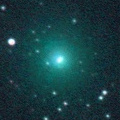
|
Now it is 12.6 mag (Mar. 8, Ken Harikae). It will be fading gradually after this. In the Northern Hemisphere, it stays observable for a long time until it fades out. But it stays extremely low. It will never be observable again in the Southern Hemisphere.
Date(TT) R.A. (2000) Decl. Delta r Elong. m1 Best Time(A, h)
Apr. 6 0 7.53 44 0.7 3.014 2.330 39 14.6 4:14 (226, 15)
Apr. 13 0 27.65 44 48.4 3.096 2.388 38 14.9 4:03 (225, 15)
|

|
Now it is 13.6 mag (Feb. 27, S. Szabo). It is expected to brighten up to 7 mag in 2020. It will be unobservable temporarily in April.
Date(TT) R.A. (2000) Decl. Delta r Elong. m1 Best Time(A, h)
Apr. 6 3 17.86 6 7.9 5.607 4.820 34 14.8 19:51 ( 91, 10)
Apr. 13 3 22.15 6 58.0 5.604 4.756 29 14.7 19:58 ( 96, 4)
|

|
It stays 15 mag from 2018 to 2019, and it will be observable for a long time in the Southern Hemisphere. In the Northern Hemisphere, it will never be observable again. It has not been observed since last October.
Date(TT) R.A. (2000) Decl. Delta r Elong. m1 Best Time(A, h)
Apr. 6 23 22.75 -49 59.1 4.366 3.959 59 14.9 4:14 (313,-28)
Apr. 13 23 32.40 -49 4.8 4.325 3.967 62 14.9 4:03 (313,-27)
|

|
Now it is 15.4 mag (Apr. 3, Toshihiko Ikemura, Hirohisa Sato). It will be fading slowly after this. It is observable in good condition in the Northern Hemisphere. In the Southern Hemisphere, it stays extremely low for a while.
Date(TT) R.A. (2000) Decl. Delta r Elong. m1 Best Time(A, h)
Apr. 6 15 49.61 48 7.1 3.730 4.236 113 14.9 2:55 (180, 77)
Apr. 13 15 43.36 48 20.4 3.765 4.287 115 15.0 2:21 (180, 77)
|
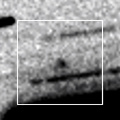
|
It will brighten up to 14 mag from May to June. However, it locates very low in the Northern Hemisphere, and it is not observable in the Southern Hemisphere.
Date(TT) R.A. (2000) Decl. Delta r Elong. m1 Best Time(A, h)
Apr. 6 23 21.91 34 27.1 2.285 1.587 35 15.3 4:14 (239, 17)
Apr. 13 23 41.95 38 40.3 2.198 1.531 37 15.1 4:03 (235, 18)
|
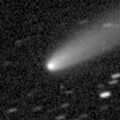
|
Now it is 14.3 mag (Apr. 7, Chris Wyatt). It will be fading after this, and it will be fainter than 18 mag in May.
Date(TT) R.A. (2000) Decl. Delta r Elong. m1 Best Time(A, h)
Apr. 6 11 20.98 -3 24.2 1.009 1.965 155 15.2 22:23 ( 0, 52)
Apr. 13 11 20.22 -2 56.4 1.074 2.001 148 15.6 21:55 ( 0, 52)
|

|
Now it is 15.2 mag (Apr. 2, Toshihiko Ikemura, Hirohisa Sato). It will be fading slowly after this. It is observable in excellent condition until spring in the Northern Hemispehre. In the Southern Hemisphere, it will be hardly observable after this.
Date(TT) R.A. (2000) Decl. Delta r Elong. m1 Best Time(A, h)
Apr. 6 9 2.14 41 10.1 4.740 5.145 108 15.2 20:05 (180, 84)
Apr. 13 8 56.40 40 18.6 4.891 5.184 101 15.3 19:58 (137, 83)
|
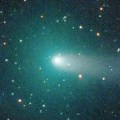
|
It brightened up to 9.5 mag from autumn to winter (Dec. 14, Marco Goiato). Now it is fading. It has already faded down to 14.5 mag (Apr. 2, Toshihiko Ikemura, Hirohisa Sato). In the Northern Hemisphere, it stays observable in good condition for a long time until it fades out. It locates low in the Southern Hemispehre.
Date(TT) R.A. (2000) Decl. Delta r Elong. m1 Best Time(A, h)
Apr. 6 8 59.51 40 39.1 1.858 2.370 108 15.2 20:03 (180, 85)
Apr. 13 9 7.58 39 22.9 1.984 2.428 103 15.6 19:58 (147, 85)
|

|
It brightened up to 9.0 mag from autumn to winter (Nov. 16, Maik Meyer). Now it is fading. It has already faded down to 15.4 mag (Apr. 2, Toshihiko Ikemura, Hirohisa Sato). It is observable in excellent condition in the Northern Hemisphere. It stays low in the Southern Hemisphere.
Date(TT) R.A. (2000) Decl. Delta r Elong. m1 Best Time(A, h)
Apr. 6 6 23.01 23 3.0 2.157 2.209 79 15.2 19:51 ( 79, 57)
Apr. 13 6 36.40 22 34.5 2.288 2.263 75 15.7 19:58 ( 82, 52)
|
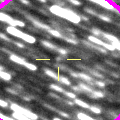
|
Now it is 16.4 mag (Mar. 11, Toshihiko Ikemura, Hirohisa Sato). It will brighten up to 15 mag from May to June, and it will be observable in good condition.
Date(TT) R.A. (2000) Decl. Delta r Elong. m1 Best Time(A, h)
Apr. 6 20 24.91 3 54.6 1.741 1.650 67 15.4 4:14 (293, 35)
Apr. 13 20 44.76 7 30.2 1.691 1.625 68 15.2 4:03 (289, 37)
|

|
It is expected to brighten up to 10 mag in autumn. Now it is 16.0 mag (Apr. 1, Toshihiko Ikemura, Hirohisa Sato). In the Northern Hemisphere, it stays observable for a long time while the comet is brightening. In the Southern Hemisphere, it it not observable until mid September.
Date(TT) R.A. (2000) Decl. Delta r Elong. m1 Best Time(A, h)
Apr. 6 2 59.85 78 29.6 2.597 2.512 73 15.6 19:51 (166, 35)
Apr. 13 3 11.64 75 58.6 2.619 2.443 68 15.5 19:58 (163, 33)
|

|
Now it is 14.2 mag (Feb. 4, ATLAS-MLO, Mauna Loa). It will be fading gradually after this. It is observable in excellent condition in the Northern Hemisphere. In the Southern Hemisphere, it is not observable until summer.
Date(TT) R.A. (2000) Decl. Delta r Elong. m1 Best Time(A, h)
Apr. 6 9 28.06 61 56.4 2.103 2.495 100 15.5 20:31 (180, 63)
Apr. 13 9 32.25 58 59.8 2.191 2.535 98 15.6 20:08 (180, 66)
|

|
First return of a new periodic comet discovered in 2014. The condition of this apparition is excelllent. It was expected to brighten rapidly, and to be observable at 15.5 mag in excellent condition in March. But it has not been recovered yet. Now it is fainter than 19 mag (Mar. 28, Jean-Francois Soulier).
Date(TT) R.A. (2000) Decl. Delta r Elong. m1 Best Time(A, h)
Apr. 6 10 8.82 12 5.8 0.857 1.712 134 16.0 21:12 ( 0, 67)
Apr. 13 10 12.79 12 3.2 0.889 1.703 128 16.1 20:48 ( 0, 67)
|
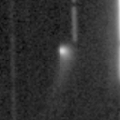
|
Now it is 16.5 mag (Apr. 1, Toshihiko Ikemura, Hirohisa Sato). It will be fading after this. In the Northern Hemisphere, it stays observable for a long time, but it will be extremely low from May to June. It is not observable at all in the Southern Hemisphere.
Date(TT) R.A. (2000) Decl. Delta r Elong. m1 Best Time(A, h)
Apr. 6 3 43.26 54 35.5 3.779 3.370 58 16.2 19:51 (136, 36)
Apr. 13 3 45.62 53 24.7 3.892 3.386 53 16.2 19:58 (136, 31)
|
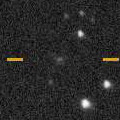
|
Now it is 17.4 mag (Jan. 3, Toshihiko Ikemura, Hirohisa Sato). It stays 16 mag for a long time from 2019 to 2020. It is observable in excellent condition in the Southern Hemisphere. It is hardly observable in the Northern Hemisphere.
Date(TT) R.A. (2000) Decl. Delta r Elong. m1 Best Time(A, h)
Apr. 6 13 11.72 -56 43.2 3.381 4.089 129 16.3 0:19 ( 0, -2)
Apr. 13 12 55.37 -57 33.9 3.328 4.056 130 16.2 23:29 ( 0, -3)
|
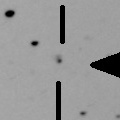
|
Asteroid, but it brightened rapidly. Now it is 17.3 mag (Nov. 14, Kunihiro Shima). It is observable in excellent condition in the Southern Hemisphere. It is hardly observable in the Northern Hemisphere.
Date(TT) R.A. (2000) Decl. Delta r Elong. m1 Best Time(A, h)
Apr. 6 22 27.51 -36 3.0 7.029 6.507 54 16.6 4:14 (305,-13)
Apr. 13 22 28.18 -36 6.2 6.927 6.499 60 16.6 4:03 (307,-10)
|

|
Now it is 17.1 mag (Apr. 3, Toshihiko Ikemura, Hirohisa Sato). It stays 16-17 mag for a long time until 2020. It is observable in good condition in the Northern Hemisphere. It is not observable at all in the Southern Hemisphere.
Date(TT) R.A. (2000) Decl. Delta r Elong. m1 Best Time(A, h)
Apr. 6 10 56.78 72 54.0 8.240 8.449 98 16.7 21:59 (180, 52)
Apr. 13 10 52.81 72 19.5 8.298 8.450 95 16.7 21:28 (180, 53)
|

|
Now it is 17.3 mag (Apr. 1, Toshihiko Ikemura, Hirohisa Sato). It is observable at 17 mag in good condition in 2019. It locates somewhat low in the Northern Hemisphere.
Date(TT) R.A. (2000) Decl. Delta r Elong. m1 Best Time(A, h)
Apr. 6 15 55.76 -16 26.2 3.050 3.826 135 16.9 3:01 ( 0, 39)
Apr. 13 15 53.49 -16 21.7 2.989 3.834 142 16.9 2:32 ( 0, 39)
|

|
Although it was faint as 16-17 mag in November, it brightened up to 14.7 mag in December (Dec. 12, Toshihiko Ikemura, Hirohisa Sato). Now it is fading. It has already faded down to 16.9 mag (Apr. 2, Toshihiko Ikemura, Hirohisa Sato). In the Northern Hemisphere, it stays observable in excellent condition after this. It stays extremely low in the Southern Hemisphere.
Date(TT) R.A. (2000) Decl. Delta r Elong. m1 Best Time(A, h)
Apr. 6 10 31.36 41 43.3 2.508 3.150 121 17.0 21:34 (180, 83)
Apr. 13 10 29.73 40 53.5 2.607 3.181 116 17.1 21:05 (180, 84)
|

|
Now it is 16.7 mag (Apr. 3, Toshihiko Ikemura, Hirohisa Sato). It is expected to be observable at 5-6 mag for a long time from 2022 to 2023. In the Northern Hemisphere, it is not observable at the highlight from 2022 summer to 2023 summer. In the Southern Hemisphere, it stays unobservable for a while. But it will be observable in good condition at the highlight.
Date(TT) R.A. (2000) Decl. Delta r Elong. m1 Best Time(A, h)
Apr. 6 18 13.41 55 58.0 11.871 11.931 91 17.1 4:14 (203, 66)
Apr. 13 18 12.40 56 25.9 11.804 11.886 92 17.1 4:03 (197, 67)
|
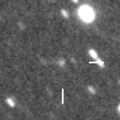
|
It will brighten up to 16.5 mag in June. It is observable in excellent condition in the Southern Hemisphere. It locates low in the Northern Hemisphere. It has not been observed since last October.
Date(TT) R.A. (2000) Decl. Delta r Elong. m1 Best Time(A, h)
Apr. 6 18 49.92 -28 25.2 3.680 3.890 94 17.2 4:14 (336, 22)
Apr. 13 18 45.40 -29 38.3 3.525 3.868 102 17.1 4:03 (341, 23)
|
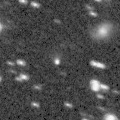
|
It had been brightening even after the perihelion passage, and it brightened up to 16.6 mag (Feb. 1, Toshihiko Ikemura, Hirohisa Sato). Now it is fading. It has already faded down to 18.4 mag (Apr. 1, Toshihiko Ikemura, Hirohisa Sato).
Date(TT) R.A. (2000) Decl. Delta r Elong. m1 Best Time(A, h)
Apr. 6 8 47.13 -0 41.5 1.195 1.877 117 17.2 19:51 ( 0, 54)
Apr. 13 8 57.37 -0 32.3 1.279 1.912 113 17.3 19:58 ( 11, 54)
|
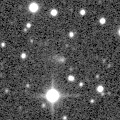
|
Now it is 16.9 mag (Apr. 2, Toshihiko Ikemura, Hirohisa Sato). It stays 17 mag from spring to summer. But it is hardly observable. In the Northern Hemisphere, it is observable only until May. In the Southern Hemisphere, it stays locating extremely low.
Date(TT) R.A. (2000) Decl. Delta r Elong. m1 Best Time(A, h)
Apr. 6 5 21.25 40 50.4 2.578 2.387 67 17.3 19:51 (114, 50)
Apr. 13 5 36.86 39 58.8 2.611 2.352 64 17.3 19:58 (114, 46)
|

|
Now it is 17.1 mag (Apr. 1, Toshihiko Ikemura, Hirohisa Sato). Fading slowly. It stays observable at 17 mag in good condition until summer.
Date(TT) R.A. (2000) Decl. Delta r Elong. m1 Best Time(A, h)
Apr. 6 11 30.87 9 53.6 9.167 10.070 153 17.3 22:33 ( 0, 65)
Apr. 13 11 29.69 10 8.5 9.235 10.082 145 17.3 22:04 ( 0, 65)
|
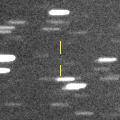
|
Now it is 19.3 mag (Mar. 11, Toshihiko Ikemura, Hirohisa Sato). It will brighten rapidly after this. It will be observable at 13.5 mag in good condition in autumn.
Date(TT) R.A. (2000) Decl. Delta r Elong. m1 Best Time(A, h)
Apr. 6 17 39.06 -10 29.3 2.222 2.737 110 17.6 4:14 (350, 44)
Apr. 13 17 43.44 -9 50.4 2.098 2.692 115 17.4 4:03 (354, 45)
|

|
First return of a new periodic comet which brightened up to 16.5 mag in 2005. Now it is 17.8 mag (Apr. 1, Toshihiko Ikemura, Hirohisa Sato). It stays 17.5 mag until early summer.
Date(TT) R.A. (2000) Decl. Delta r Elong. m1 Best Time(A, h)
Apr. 6 13 8.81 -9 0.2 2.106 3.105 176 17.5 0:15 ( 0, 46)
Apr. 13 13 4.72 -8 36.9 2.084 3.085 175 17.5 23:39 ( 0, 46)
|

|
In the Southern Hemisphere, it is observable at 17.5 mag in good condition from spring to summer. In the Northern Hemisphere, it is not observable at all. It has not been observed since last September.
Date(TT) R.A. (2000) Decl. Delta r Elong. m1 Best Time(A, h)
Apr. 6 17 17.02 -54 27.3 3.955 4.390 109 17.9 4:14 (359, 1)
Apr. 13 17 17.33 -55 5.9 3.873 4.390 114 17.9 3:56 ( 0, 0)
|
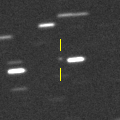
|
Now it is 17.8 mag (Apr. 1, Toshihiko Ikemura, Hirohisa Sato). It is observable at 18 mag in good condition from March to April.
Date(TT) R.A. (2000) Decl. Delta r Elong. m1 Best Time(A, h)
Apr. 6 14 13.27 16 47.2 1.966 2.878 150 17.9 1:19 ( 0, 72)
Apr. 13 14 6.76 17 25.2 2.002 2.923 151 18.0 0:45 ( 0, 72)
|

|
Now it is 18.2 mag (Apr. 2, Toshihiko Ikemura, Hirohisa Sato). It was observed at 16 mag from 2017 to 2018. Now it is fading. It is observable at 18 mag in good condition in this spring.
Date(TT) R.A. (2000) Decl. Delta r Elong. m1 Best Time(A, h)
Apr. 6 16 5.30 10 6.1 6.833 7.522 130 17.9 3:11 ( 0, 65)
Apr. 13 16 3.50 10 56.9 6.802 7.550 135 17.9 2:41 ( 0, 66)
|

|
Main-belt asteroid. But it shows a straight tail like a comet. Now it is 17.3 mag (Apr. 1, Toshihiko Ikemura, Hirohisa Sato). It stays observable in excellent condition until early summer.
Date(TT) R.A. (2000) Decl. Delta r Elong. m1 Best Time(A, h)
Apr. 6 9 59.74 2 18.9 1.469 2.287 134 18.0 21:02 ( 0, 57)
Apr. 13 9 59.37 3 55.6 1.516 2.271 127 18.1 20:34 ( 0, 59)
|
|
![]()
 P/2014 C1 ( TOTAS )
P/2014 C1 ( TOTAS ) C/2018 A3 ( ATLAS )
C/2018 A3 ( ATLAS ) C/2018 F4 ( PanSTARRS )
C/2018 F4 ( PanSTARRS ) A/2017 U7
A/2017 U7 C/2010 U3 ( Boattini )
C/2010 U3 ( Boattini ) 74P/Smirnova-Chernykh
74P/Smirnova-Chernykh 240P/NEAT
240P/NEAT C/2017 K2 ( PanSTARRS )
C/2017 K2 ( PanSTARRS ) C/2018 KJ3 ( Lemmon )
C/2018 KJ3 ( Lemmon ) 239P/LINEAR
239P/LINEAR C/2018 X2 ( Fitzsimmons )
C/2018 X2 ( Fitzsimmons ) C/2014 B1 ( Schwartz )
C/2014 B1 ( Schwartz ) 68P/Klemola
68P/Klemola P/2018 X1 ( LONEOS )
P/2018 X1 ( LONEOS ) 186P/Garradd
186P/Garradd 49P/Arend-Rigaux
49P/Arend-Rigaux C/2017 E3 ( PanSTARRS )
C/2017 E3 ( PanSTARRS ) (6478) Gault
(6478) Gault![]()




































